The American Pitbull Terrier is a misunderstood dog in many ways. But for those of us that know a Pitbull, know that there are a million reasons to love them. From their loving nature to their smiley faces, all the way down to their gorgeous paws.
Each Pitbull is unique, but some are rarer than others. The most unique of them all? That would be the blue nosed Pitbull. But what is so special about this interestingly colored pup? Is he the same as any other Pitbull, or is he a mix of another dog breed? Well, you’ve come to the right place to find out.
Here in this guide we are going to take you through everything you need to know, from his history to his health, his personality through to his exercise needs. We’ll also take a look at the genetics behind his distinctive coloring, and just how he gets that gorgeous blue nose color of his. So, let’s jump straight in and take a nosey at the blue details.
Breed History
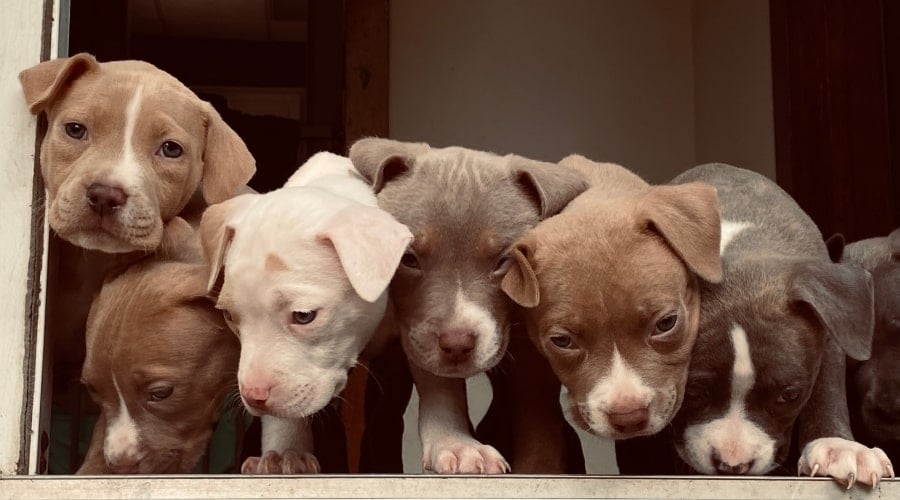
Unfortunately, this breed has a checkered past. And it is his past that has had such a negative influence on his present. His ancestors originated from across the pond, in England in the 19th Century. They were used in dog fights against bulls, rats, and other dogs for betting. These dogs were chosen for the blood sport because of their terrier tenacity and powerful strength.
When the blood sport was outlawed in England, the human ring leaders flew them to America, where they continued the sport for a while. The largest specimens of the breed were mated to create a bigger version that we now know as the American Pitbull Terrier. Nowadays, they are not used for dogfighting. Instead, they make fantastic herders, and even better than this, family companions.
It is not known when the first dog with this coloring came into existence. But it is likely that as soon as a standard black-nosed Pitbull was born, a blue nose Pitbull wasn’t too far behind. Ever since then, we have been fascinated with the more unique things in life. And as their Pitbull reputation is slowly improving thanks to awareness and education, dogs with this coat color are becoming more popular than ever.
Pitbull Breeds

The term ‘Pitbull’ is an umbrella term for a group of Pitbull type dogs who descend from Terriers and Bulldogs. When referring to a Pitbull, most people are referring to the American Pitbull Terrier. The other dog breeds sometimes referred to as a Pitbull, are the American Staffordshire Terrier, the Staffordshire Bull Terrier, and the American Bully.
There are the three types of dogs often referred to as the Pitbull Terrier. Pitbulls have several designations assigned by breeders, with the most common being traditional black nosed, the red nosed, and the blue nosed. The red nosed and the blue nosed are the rarest, and we’ll explain why in the next section.
Color Genetics

You already know that this color combination is rare, but why is that? Well, it’s all to do with his genetics. Without getting too scientific and complicated, you need a quick gene lesson to understand the rarity of this coat color. Unfortunately, DNA is not as easy as ABC, but we’ll try and make it simple for you.
Puppies, just like all animals, inherit sets of genes that determine specific characteristics. Mom will have one gene, and so will dad, and the combination of these genes will select the color of his nose, skin, and eyes, and so on. A dominant gene will rule over a recessive gene. A dominant gene is characterized by a capital letter, and a recessive gene is a lowercase letter.
In the case of the blue nose gene, the blue gene is the diluted version of the black gene. The MLPH gene (also known as melanophilin) is responsible for the coloring of genes. A mutation in this gene causes the color to dilute. This mutation is a recessive gene, and in the world of genetics, it is called a d-allele or a d-locus.
So, if mom is D/D and dad is D/D, the puppy will be D/D, which means a black nosed pup. If mom is D/d and dad is D/d (which means they both carry the recessive gene, but the capital letter overrides it), the puppy will again be black nosed. But, if mom is d/d and so is dad, the pup will also be d/d (because there are no capital D’s to override the little ones). This means the pup will exhibit the diluted color.
It’s worth noting that two standard black noses can have a blue nosed pup as they are recessive gene carriers, but they are rare. If you’re really interested in the science behind it, there is lots of more information available online. But all you really need to know is that the diluted blue color nose is much rarer than the standard black color.
Appearance

The blue nosed American Pitbull Terrier is practically the same as any other Pitbull. Except that he has a blue nose. When we say blue, we don’t mean Smurf blue. Instead, we mean a diluted black. This can be dark gray to light gray in color. His nose is framed by his wide cheeky grin, and his ears are flower-shaped. His head and nose are square in shape, and his tail is long, thin, and points to the sky.
Blue nosed Pitbulls tend to inherit the complimentary blue coat too, with silver or blue eyes. Traditional American Pitbull Terrier colors include cream, black, brown, brown, brindle, or any variation of these colors. His coat is short and shiny and requires very little grooming.
These pups typically measure between 17 and 21 inches, from paw to shoulder, and he will weigh between 50 and 65 pounds. This makes him a medium to a large-sized pooch who is stocky and athletic in appearance. If he is given a high-quality diet and he is exercised well, he will look like he has muscles on his muscles.
The only colored Pitbull that is not accepted in show, or seen as a fault, is a merle colored Pitbull. Merle is not a true Pitbull color, and somewhere along the line, another breed with the merle gene would have been mixed into the gene pool. Unscrupulous breeders will try to convince buyers that a merle colored Pitbull is a rare and unique specimen, and charge a premium.
If you find a merle colored dog for sale, he is not a real Pitbull. Be wary of the breeder, don’t pay, and walk away. Yes, some reputable breeders will charge a little extra for this color because of supply and demand. But do not go overboard paying for a specific appearance. At the end of the day, his personality and bond with you are far more important than the color of his nose.
Temperament

Despite his aggressive reputation, he really is anything but. In fact, to put this myth to rest, of nearly 1,000 Pitbulls tested by the American Temperament Test Society, almost 90% of them passed the personality test. Meaning that they were friendly and well-mannered. Compared to another family favorite, the Dachshund, where less than 70% of them passed. The Pitbull is one of the best scoring dog breeds.
Now that that’s been put to rest, we can tell you that these pups are lovable goofballs. He loves nothing more than to have fun with his family and play or do whatever you want to. Be that fetch, jogging, flyball, tug-of-war, or just general mucking about, they are game for anything. This makes him a fun family companion.
He is very loving, affectionate, and a real soppy pooch. This is why he makes a great therapy dog and loves to make people feel better. Back in his fighting days, he was trained not to harm his humans, and he carries this instinct with him to this day. He is loyal and eager to please and would do anything to make you happy.
He also extends this friendliness to strangers and intruders. So, if you’re looking for a guard dog, you may want to consider another breed. He’ll welcome all with open arms, which is excellent if you are a sociable family with lots of people coming and going.
He does not, however, extend this friendliness to rodents and other smaller animals. Remember his ratting history? Even if he is well-socialized, he might not get on well in a house with pet rats. If he is socialized well, other dogs are fine, rodents are not. If you are a multi-pet household, be sure to hold a controlled pre-meet before making any commitments.
Exercise And Training

These pups are energetic dogs who need at least 60 minutes of exercise every day. Come rain or shine, without fail, this dog needs to expel that intense energy of his. Without an outlet, he will become problematic, unruly, and also destructive. That favorite armchair of yours? It doesn’t stand a chance against a bored pup.
In addition to this, he also needs interactive playtime throughout the day. This stimulates his brain, keeps him busy, and it will reinforce your bond with him. These pups are tough cookies, and he needs tough toys, so be sure to invest in a bunch of indestructible dog toys to keep him happy.
His tenacity and loyal nature make him an eager to please dog who will listen to everything you say. With persistent training, this pup is a delight to train. All you need is a few treats in hand and a perfect ‘who’s a good boy?’ squeaky voice. Be sure to read up on the positive reward training method, and he’ll be obedient in no time.
Socialization is key with these pups, because of his dog-fighting history. If he is socialized well, he is one of the friendliest dogs around. But if not, you will have a problem on your hands. Reputable breeders will socialize him before you get him. So, be sure to continue this by mixing him with other dogs and unfamiliar situations, and build his confidence.
Health

When it comes to his health, there is a slight difference between these pups and the standard black-nosed Pitbull. This is all the more reason to work with a reputable breeder who will do their best to produce the healthiest puppies possible.
Unfortunately, research shows that the mutated gene that causes the light blue color is a result of low melanin levels. Melanin is a broad term for the pigmentation of skin, hair, and eye. Low melanin levels can cause other health concerns, such as skin conditions, heart diseases, eye conditions, lower immunity, and a higher chance of developing cancer.
This is something to bear in mind if you are seeking out a blue nosed Pitbull. Because his life might be a bit more troublesome compared to a traditional black-nose. It might also cost you a little bit more when it comes to vet bills and insurance too.
Thankfully, though, the American Pitbull Terrier is a very healthy breed. The most two common concerns are hip dysplasia and skin allergies. Cerebellar abiotrophy is also found in the breed, which can reduce his mobility, but this is less common. He usually enjoys a long lifespan of 12 to 16 years.
Nutrition

Their kibble needs premium quality Pitbull dog food that will keep him sustained throughout the day. A kibble with a high-protein content is desirable, so look to feed him a protein content of at least 25%. He will also probably eat around 1,100 calories per day, which equates to 2 ½ cups of food, and more if he is a working Pitbull.
This variation of the breed is more likely than a standard black-nosed Pitbull to suffer from skin allergies. So, always be sure to keep an eye on the condition of his skin, because what you put in his bowl can affect it. If you notice that he is scratching his skin more than usual, if he has red or inflamed skin, or if he is losing hair in patches, take him to the vet. These are all signs of an allergic reaction, and it could be his food.
Grooming

The blue nosed Pitbull has a short and sleek coat that needs very little grooming. This is fantastic news considering how much time you need to devote to his exercise needs. He will only need a brush two to three times per week, as Pitbulls are year-round shedders. This will help to remove dead fur, spread his natural coat oils around, and generally keep him looking smart.
He will need a bath once every 8 to 12 weeks or so to keep him smelling fresh. Again, because he is known to have sensitive skin, always wash him with a gentle shampoo. Look for ones made with natural ingredients, such as oatmeal, and they should not aggravate his skin. If he does have very sensitive skin, your vet may prescribe him a medicated shampoo.
All of his other grooming regimes, such as eye, ear, and dental cleaning, are the same as any other dog. Do these at least once a week, and it is also a great way to bond with him too. Thankfully, because he is so energetic, you shouldn’t have to clip his nails because they will wear down naturally.
Breeders And Puppy Prices
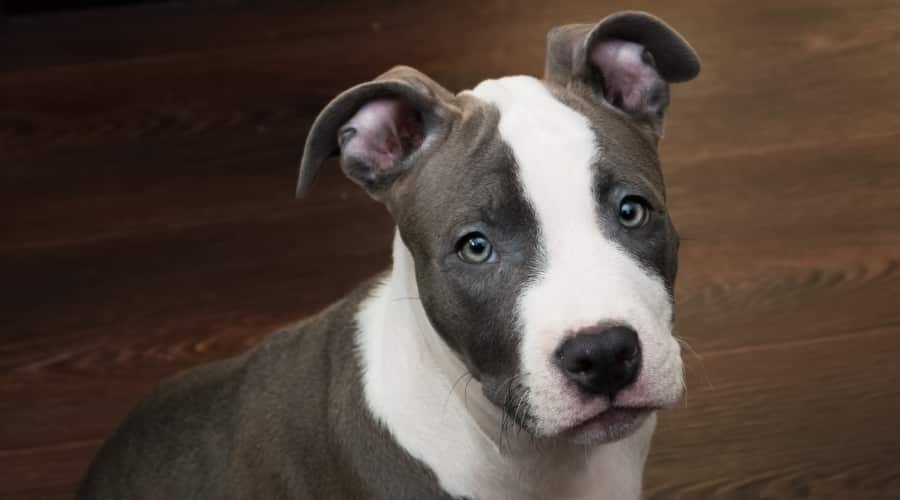
Because this color combination is rare, many unscrupulous breeders will breed blue noses together. This is regardless of whether they are ill, too old, too young, or closely related (i.e., a parent with pup or siblings with siblings). This practice is called inbreeding, and it can cause serious health problems because the gene pool is limited.
If you are determined to have a blue nosed Pitbull, you should always work with a reputable breeder who would never create their dogs through inbreeding. Yes, you might have to pay a little more for them, but you can guarantee that the chances of them being healthy are much higher. In the long run, this will probably save you lots in vet bills too.
From a reputable breeder, you can expect to pay anywhere between $1,000 and $3,000 for a purebred puppy. If you’re wondering how to find a reputable breeder, look for one with a professional website (no ads on Craigslist), and breeders who will invite you to see the pups and their parents in person. Ask for health clearances, and reviews from previous customers are great too.
If you are thinking about rescuing, you probably won’t be surprised to learn that there are more Pitbulls in rescue shelters than any other dog breed. Although this is sad, it means many lovely Pitbulls are waiting for their forever home. Visit your local rescue centers, or dedicated Pitbull Rescue websites, and speak to the contacts there about finding one with this coat color.
Frequently Asked Questions
Blue Nose Pitbull vs. Red Nose Pitbull: What’s the difference?
The difference between the two is the nose and coat coloring. The blue nose is as a result of a diluted recessive gene, and the red nose is a result of another rare recessive gene. Both the blue and the red-nose are rarer than the standard black-nose Pitbull.
How do I know if I have a Blue Nose Pitbull?
If you stood your blue nose Pitbull next to any black-nosed dog (which is the majority of dogs) you’d be able to instantly tell the difference. Their noses are s a more subtle grayish-blue, which is diluted black.
Can I register my dog with the AKC?
No. Unfortunately, the American Kennel Club does not recognize the American Pitbull Terrier as a breed. Instead, you will have to register him with the United Kennel Club. And thankfully, they accept this coat color. The only color that they do not recognize is the merle coat and those Pitbulls with albinism.
Do they make good family pets?
Yes. Just like any American Pitbull Terrier, the blue makes a fantastic family pet. Not only are they loving and sweet, but they are also fun, energetic, loyal, and smiley. Everything you could wish for in a family dog! Of course, you need to be the right family, but if you can tick all of their boxes, it is going to be an excellent bond for sure.
Are they illegal?
This is dependent on where you live, but if Pitbulls are allowed, the blue nose is allowed too. Some geographic areas have breed restrictions. If the Pitbull is banned in a particular area, so too is this variation of the breed. If you are thinking about welcoming one into your life, be sure to check out your local laws, as well as tenancy agreements and insurance requirements, etc.
Final Thoughts
So, there you have it, everything that you need to know about the blue nosed American Pitbull Terrier, and his blue nose. As well as everything else that you need to understand if you are thinking about welcoming this pup into your life.
Hopefully, we have made your decision a little clearer if you were wondering whether he is the right canine for you. As well as putting straight some Pitbull truths and myths. Overall, just like any Pitbull, he makes a fantastic family pet and a loyal sidekick. He also makes a hardworking ranch colleague if you need to employ a canine herder.
He is almost the same as any other Pitbull, except that he is rarer to find, more expensive to purchase, and he has a few extra health concerns to contend with. But if you work with a reputable breeder, your chances of a healthy blue are increased for sure.

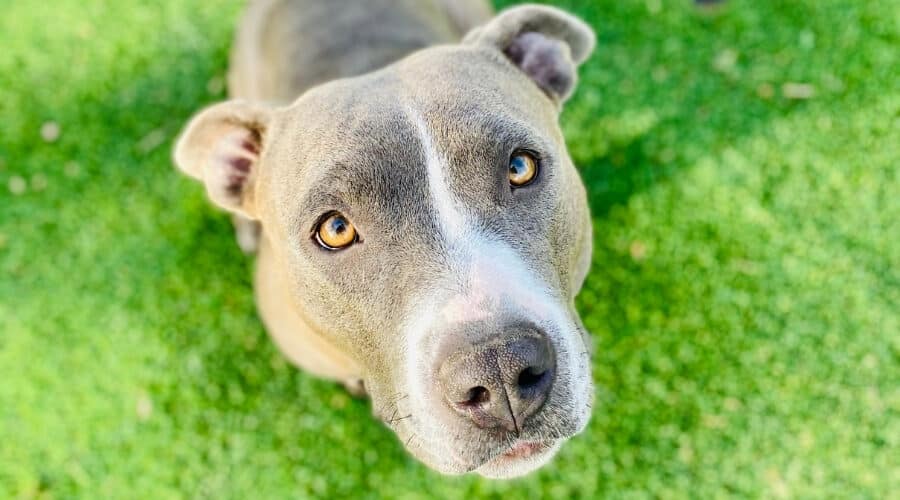
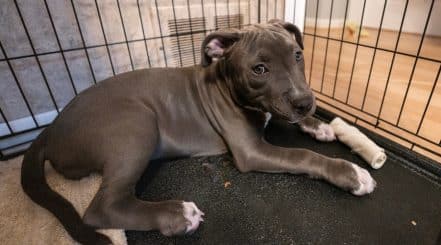
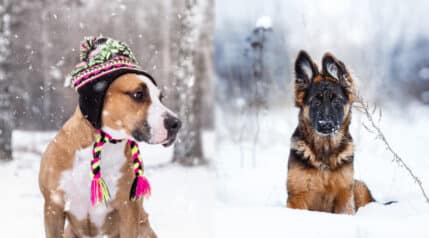
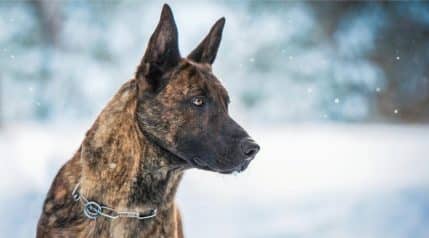
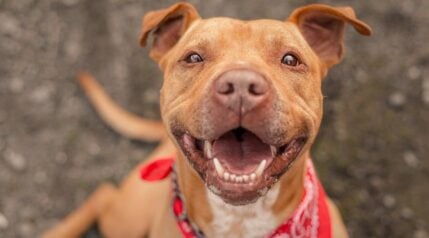
Reading this was very helpful and learning experience
Can I have her bloodline checked to see if she’s full blooded
Getting a DNA test is probably your best bet. Today there are several reputable ones available on the marketplace that you can do at home or your vet can also perform one, if you prefer.
The dogs look so nice
I have a one and a half year old blue nose pitbull female beautiful looking to breed
I have blue nose beautiful markings 15 months
Does anyone know where I can purchase a blue nose puppy? I like in NYC.
We had our blue pid from a puppy to just a couple weeks ago she was 8 years old the bet personality and such a great member of the family she went every where with us great with our kids and grandkids she got sick and passed we were heat broken it was just like loosing a member of the family if I every get another one it will be a blue noise pit and hopefully I can find one like her black with Hazel eyes
I just got my first blue and he is absolutely beautiful. Odin is 13 weeks It’s an adjustment going back to the puppy stage. And it’s new adjustment to my 7yr old rednose Zeus but they are doing pretty well this far I’ve got good hopes on this union
I just adopted the sweetest 2 and 1/2 year old blue female named Lily. Poor girl was surrendered due to her previous owner living in an apartment building. She is very overweight and after reading this article, it may be due to inactivity. We went for a jog today on leash and she did very well.
Thank you for adopting Lily! So happy to hear she did well on your jog!
Looking for a PitBul Pup……
Beautifully written with great information. Just lost my boy Blue due to an enlarged heart three weeks ago. He was an amazing dog who helped raise five grandchildren and a nephew with no sign of any aggression. Will be looking for my next pup soon.
Sounds like a great dog, Paul! Thanks for stopping by to comment!
Thank you, this was a very educational website! My dog is the greatest dog ever. He’s a Blue-Nose and I adopted him from the pound as a rescue. Thank you for all your advice!
Hi Laura – sounds like a great dog! Thank you for stopping by, and thank you for rescuing!
We just got our first blue nosed pup. We had to put down our other dog about a month ago. I’ve always wanted a blue now we have one. She is the cutest and most sweet 9-week old dog I’ve ever had. I did a LOT of research on them before pulling the trigger because the wife was leary. I’m so glad we did it. I love her to death!
Thanks for commenting, Kevin! Sounds like an amazing pup!
We have a pitbull puppy who is 3 to 4 months old, she is a female her name is sassy girl. I love her to death, she helps me with my depression, she listens, and is very smart too.
Hi Vanessa! Thanks for stopping by to comment, sounds like a great pup!
A very well written, and informative article. I definitely appreciate the Blue Nose American Pitbull Terrier breed; the character and behavioral portions of the article are spot on.
Thank you for stopping by to comment, Michael! We appreciate your feedback, and we also love these pups!